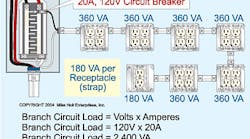Q. What is the maximum number of 15A or 20A, 125V receptacle outlets permitted on a 20A, 120V general-purpose branch circuit in a commercial occupancy?
A. For commercial occupancies, the NEC requires each receptacle outlet to be calculated at 180VA [220.14(I)]. Therefore, the maximum number of receptacles permitted on a 20A circuit would be 13 (Fig. 1 at right).
Circuit VA=Volts×Amperes
Circuit VA=120V×20A
Circuit VA=2,400VA
Number of Receptacles=2,400VA“180VA
Number of Receptacles=13
Note: According to the NEC Handbook, published by the NFPA, general-purpose receptacles aren't considered a continuous load.
Q. What is the maximum number of 15A or 20A, 125V receptacle and lighting outlets permitted on a 15A, 120V general-purpose branch circuit in a dwelling unit?
A. The NEC doesn't limit the number of receptacle and lighting outlets on a general-purpose branch circuit in a dwelling unit. See the NFPA's NEC Handbook for more information.
Although there's no limit to the number of lighting and/or receptacle outlets on dwelling general-purpose branch circuits, the NEC does require a minimum number of circuits to be installed for general-purpose receptacles and lighting outlets [210.11(A)]. In addition, the receptacle and lighting loads must be evenly distributed among the required circuits [210.11(B)].
Caution: Although it's unlikely, your jurisdiction might have a local electrical requirement that limits the number of receptacles and lighting outlets on a general-purpose branch circuit.
Q. Does the Code limit using service entrance cable as a feeder or branch circuit?
A. According to 338.10, all circuit conductors must be insulated, including the grounded neutral conductor. However, a bare conductor can be used for the grounded neutral conductor when the cable is used as a feeder to a remote building in accordance with 250.32.
Service-entrance cable used for interior branch circuits or feeders must be installed in accordance with Parts I and II of Art. 334, excluding 334.80. Basically, this means that Type SE cable must be installed as if it were nonmetallic-sheath cable, with the exclusion on conductor sizing as it relates to 60°C terminals.
Caution: Underground service-entrance cable (Type USE) can't be used for interior wiring because it doesn't have flame-retardant insulation.
Q. What are the installation requirements for dwelling unit lighting outlets and switches?
A. According to 210.70, at least one wall switch-controlled lighting outlet must be installed in every habitable room and bathroom of a dwelling unit. In other than kitchens and bathrooms, a receptacle controlled by a wall switch can be used instead of a lighting outlet. Lighting outlets can be controlled by occupancy sensors equipped with a manual override that permits the sensor to function as a wall switch.
The Code contains the location requirement for the wall switched-controlled lighting outlet, but it doesn't specify the location for the switch. Naturally, you wouldn't want to install a switch behind a door or other inconvenient location, but the NEC doesn't require you to relocate the switch to suit the swing of the door. When in doubt as to the best location to place a light switch, consult the job plans or ask the customer. If you're the boss and you don't know, check with the authority having jurisdiction.
In addition, not less than one wall switch-controlled lighting outlet must be installed in hallways, stairways, attached garages, and detached garages with electric power. At least one wall switch-controlled lighting outlet must also provide illumination on the exterior side of outdoor entrances or exits with grade level access.
Q. Must a metallic tray be grounded?
A. Metallic cable trays must be effectively bonded to ensure electrical continuity and the capacity to safely conduct any fault current likely to be imposed on them [250.96(A)]. This is accomplished by bonding the metal parts to an equipment grounding (bonding) conductor that's sized to the circuit protection device in accordance with 250.122 [392.7(A)].
Note: Metallic cable trays can serve as equipment grounding (bonding) conductors where continuous maintenance and supervision ensure that qualified persons service the installed cable tray system, and the [392.3(C) and 392.7(B)]:
-
Cable tray sections and fittings are identified for grounding (bonding) purposes.
- Cable tray sections, fittings, and connected raceways are bonded to each other in accordance with 250.96, using bolted mechanical connectors or bonding jumpers sized in accordance with 250.102.
Q. Does the NEC require the metal covers of handholes to be grounded? Could I use a ground rod for this purpose?
A. Metal covers and other exposed conductive surfaces of handholes must be effectively bonded to ensure electrical continuity and the capacity to safely conduct any fault current likely to be imposed on them [250.96(A)]. This is accomplished by bonding the metal parts to an equipment grounding (bonding) conductor sized to the circuit protection device in accordance with 250.122.
Caution: A ground rod doesn't provide the effective ground-fault path necessary to clear a ground fault. Because the resistance of the earth is so high, very little current returns to the electrical supply source via the earth.
Danger: Failure to bond metal handholes and manhole covers in accordance with 250.4(A)(3) and 250.96(A) has resulted in many deaths.
Got a Code question for Mike? E-mail him at [email protected].




